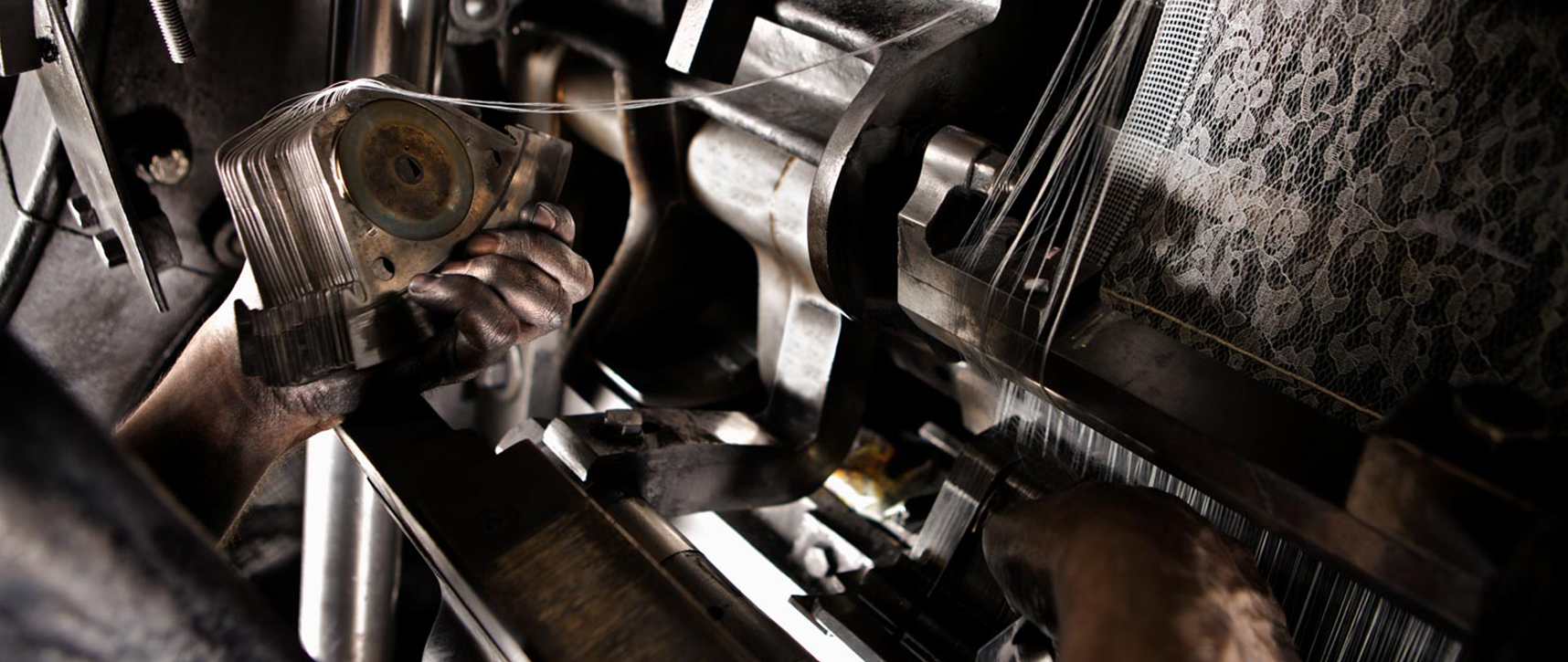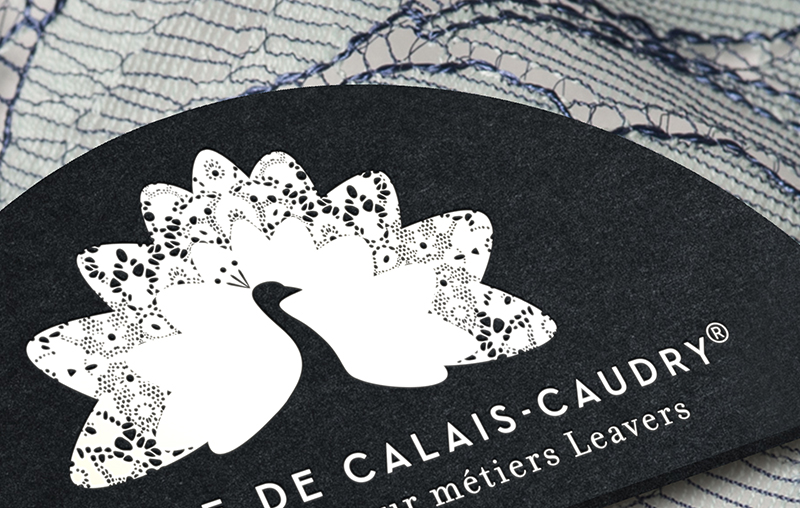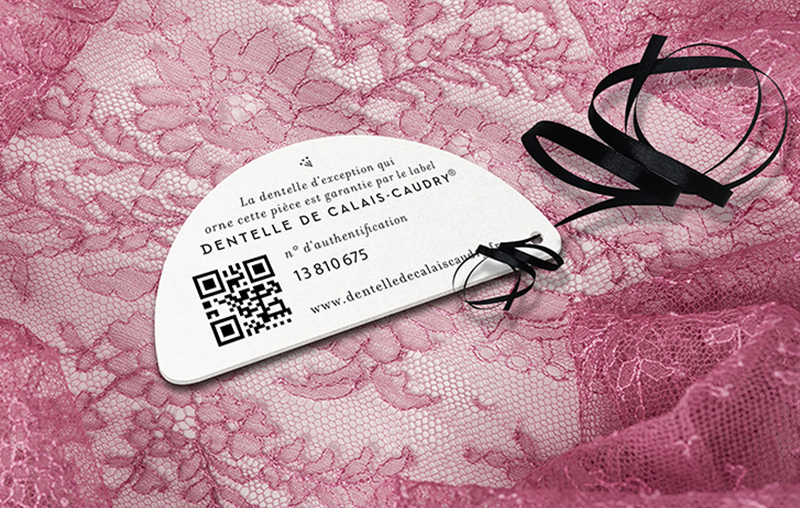 ©Ph. Schlienger
©Ph. Schlienger
EXCEPTIONAL
The craftsmanship


 ©Ph. Schlienger
©Ph. Schlienger
The craftsmanship
The art of Dentelle de Calais-Caudry® lace making is a skilled profession, with a two-hundred-year old tradition unique in the world. Most of the lace manufacturers have been awarded the title ’Entreprise du Patrimoine Vivant’ (Living Heritage company) each one of them preserving their own spirit and style, but all inevitably looking to the future. Having been in Calais or Caudry for decades, these manufacturers have an enormous collection of preciously conserved archives at their disposal, of which the oldest date back to the first half of the 19th century.
Containing the drawings of famous designers, some of which seem surprisingly modern,
these archives are a vital source of inspiration for their creative departments who are continuously reinterpreting them. The archives also attract clients drawn by the rich collection of sumptuous drawings, who delve into the huge ledgers whilst searching for original ideas for co-creating new designs.
The Leavers looms which measure six meters long and are made of cast iron weighing more than 10 tons are no longer made. Although centuries old they are still identical in the way they function, and are lovingly maintained by dedicated mechanics.
With its unrivalled technology, the Leavers loom is the only machine capable of perfectly imitating the agile hands of manual lace makers due to a complex system of knotting between the warp and the weft threads.
The bobbin threads are inserted into the chariots which move back and forth, they cross over and knot with the weft threads themselves moving from left to right, guided by the movement of the bars controlled by the Jacquard system, the ’brains’ of the loom.
The filling in of designs and all the effects are obtained with the gimp threads. The pattern borders and the flocking are made by embroidery threads.
Calais-Caudry lacemaking is a profession linked to fashion and inevitably focused on the future. Whilst respecting their heritage and their fundamental characteristics, the Calais and Caudry lace makers are continually innovating, gracefully weaving together the past and the future. The lace makers have a mastery of ancestral techniques dating back two hundred years with the Leavers loom and therefore have an all-encompassing knowledge of their product and know how to fully exploit its creative capacities.
Lace was traditionally made in silk and cotton but a huge advance was made in the 1950s with the arrival of synthetic textiles making it easier to look after. In the beginning of the 1980s the introduction of elastic fibres again boosted the lingerie sector, whose products nowadays fit better and are softer thanks to the use of microfibre and special treatments. Also over the last twenty years computer aided design as well as digital control systems on the looms have permitted lace makers to increase creativity and production.
Each season designs for new collections are presented at international trade fairs such as Premier Vision or Interfilière. New floral motifs, arabesques and interlacing, whether abstract, geometric or figurative are permanently invented, used again in different ways, reinterpreted with new stylistic approaches. For example: playing with the contrasts or shades of colours, using special yarnsÉsuch as pearlized, tweeded, two-way, metallic ones… etc.
The classical image of lace is transformed by the huge variety of materials now available.
There are finishes such as calendering for a waxed effect, laminating with PVC, transfer metallising, silicone coating… all of them resulting from extensive research and trials in partnership with specialists and textile designers, capable of transforming the lace into a new material.
Due to its avant-garde nature and the permanent quest for originality and new trends in fashion Dentelle de Calais-Caudry® can be used in ever more unprecedented and unexpected domains, such as accessories, furnishings and decoration.
Dentelle de Calais-Caudry® lace has a delicacy and incomparable transparency.
It is a fabric in a league of its own, has a sophistication which sets it apart from the rest, and in particularly from the knitted laces produced in France or elsewhere.
The unique technical capacity of the Leavers loom permits a multitude of combinations of thread intertwining, giving limitless possibilities of backgrounds and patterns. The combinations of synthetic or cellulosic yarns and the variety of different weaves are endless. All imaginable lace textures can therefore be created: from thick corded guipure lace to identical reproductions of fine Chantilly lace, and including laces such as Valenciennes, Alençon and Cluny whose names are allowed to be used due to their almost perfect imitation of the handmade laces, whilst also being labelled as Dentelle de Calais-Caudry®.
Multiple visual effects can be obtained in Dentelle de Calais-Caudry® lace (light and shade, opacity and transparency, colour graduation etc.) which can also be enhanced with relief working which gives it a ’three dimensional’ effect.
Qu’est-ce qu’un cookie ?
Un cookie est un fichier texte déposé, sous réserve de vos choix, sur votre ordinateur lors de la visite d'un site ou de la consultation d'une publicité. Il a pour but de collecter des informations relatives à votre navigation et de vous adresser des services adaptés à votre terminal (ordinateur, mobile ou tablette).
Les cookies sont gérés par votre navigateur internet et seul l’émetteur d’un cookie est susceptible de lire ou de modifier les informations qui y sont contenues.
A quoi servent les cookies émis sur notre site ?
Les cookies utilisés sur notre site permettent d'identifier les services et rubriques que l'utilisateur a visités, et plus généralement son comportement en matière de visites. Ces informations sont utiles pour mieux personnaliser les services, contenus, offres promotionnelles et bannières qui apparaissent sur notre site et faciliter votre navigation sur notre site.
Des cookies sont également nécessaires au bon fonctionnement de certains services ou encore pour mesurer leur audience.
Des cookies sont susceptibles d’être inclus dans les espaces publicitaires de notre site. Ces espaces contribuent au financement des contenus et services que nous mettons à votre disposition.
Les cookies internes
Lorsque vous vous connectez à notre site, nous pouvons être amenés, sous réserve de vos choix, à installer divers cookies dans votre terminal nous permettant de reconnaître le navigateur de votre terminal pendant la durée de validité du cookie concerné.
Les cookies que nous émettons sont utilisés aux fins décrites ci-dessous, sous réserve de vos choix qui résultent des paramètres de votre logiciel de navigation utilisé lors de votre visite de notre site.
Les cookies que nous émettons nous permettent de :
Faciliter votre navigation sur notre site
- en adaptant la présentation de notre site aux préférences d’affichage de votre terminal (langue utilisée, résolution d’affichage, système d’exploitation utilisé, etc) lors de vos visites sur notre site, selon les matériels et les logiciels de visualisation ou de lecture que votre terminal comporte
- en mémorisant des informations que vous avez choisis sur notre site (contenu consulté)
- en mettant en Å“uvre des mesures de sécurité
Décompter le nombre de pages consultés sur une partie de notre site
Le décompte des pages lues s’effectue par des cookies installés sur votre ordinateur.
Améliorer nos services
Ces cookies permettent d’établir des statistiques et volume de fréquentation et d’utilisation des divers éléments composant notre site (rubriques et contenus visité, parcours) afin d’améliorer l’intérêt et l’ergonomie de nos services.
Les Appareils Mobiles
Certains appareils mobiles envoient des informations permettant de connaître le modèle du téléphone, la version de l'OS (operating system = système d’exploitation), la connectivité, le nom et la version de l’application utilisée.
Ces données, nécessaires au bon fonctionnement du site, sont traitées automatiquement par les serveurs et certains de nos partenaires (Google Analytics) pour pouvoir vous fournir un service adapté aux caractéristiques techniques de votre appareil et mesurer l’audience de notre site.
Accepter ou refuser les cookies
Vous pouvez à tout moment choisir de désactiver ces cookies. Votre navigateur peut également être paramétré pour vous signaler les cookies qui sont déposés dans votre ordinateur et vous demander de les accepter ou pas.
Vous pouvez accepter ou refuser les cookies au cas par cas ou bien les refuser systématiquement. Nous vous rappelons que le paramétrage est susceptible de modifier vos conditions d'accès à nos contenus et services nécessitant l'utilisation de cookies.
Si votre navigateur est configuré de manière à refuser l'ensemble des cookies, vous ne pourrez pas profiter d'une partie de nos services. Afin de gérer les cookies au plus près de vos attentes nous vous invitons à paramétrer votre navigateur en tenant compte de la finalité des cookies.
Pour la gestion des cookies et de vos choix, la configuration de chaque navigateur est différente. Elle est décrite dans le menu d'aide de votre navigateur, qui vous permettra de savoir de quelle manière modifier vos souhaits en matière de cookies.
Vos choix via votre navigateur
L’accord sur les cookies
L’enregistrement d’un cookie dans un terminal est essentiellement subordonné à la volonté de l’utilisateur du Terminal, que celui-ci peut exprimer et modifier à tout moment et gratuitement à travers les choix qui lui sont offerts par son logiciel de navigation. Si vous avez accepté dans votre logiciel de navigation l’enregistrement de cookies dans votre Terminal, les cookies intégrés dans les pages et contenus que vous avez consultés pourront être stockés temporairement dans un espace dédié de votre terminal. Ils y seront lisibles uniquement par leur émetteur.
Le refus des cookies
Si vous refusez l'enregistrement de cookies dans votre terminal vous ne pourrez plus bénéficier d'un certain nombre de fonctionnalités qui sont néanmoins nécessaires pour naviguer dans certains espaces des sites.
Comment exercer vos choix, selon le navigateur que vous utilisez ?
Pour la gestion des cookies et de vos choix, la configuration de chaque navigateur est différente. Elle est décrite dans le menu d'aide de votre navigateur, qui vous permettra de savoir de quelle manière modifier vos souhaits en matière de cookies. Pour :
Microsoft Internet Explorer
Google Chrome
Safari
Firefox
Opéra
Do not track
Vous pouvez également paramétrer votre navigateur afin que celui-ci envoie un code indiquant aux sites Web que vous ne souhaitez pas être suivis. (option « Do No Track »).
Internet ExplorerTM
SafariTM
ChromeTM
FirefoxTM
OperaTM
Familles de cookies
Les cookies présents sur le site peuvent être regroupés en plusieurs familles :
Fonctionnement
Il s’agit du niveau de désactivation le plus élevé. Il ne maintient que les cookies qui garantissent le fonctionnement du site et permettent son optimisation.
Social et Webanalytics
Ce niveau de désactivation intermédiaire maintient les cookies sociaux et les cookies de Webanalytics.
Pour les mesures de trafic dites de Webanalytics, le site utilise Google Analytics. Pour bloquer l’utilisation des données par Google Analytics.
Si vous avez une question relative à l’utilisation des cookies, veuillez nous envoyer un message à l’adresse suivante : contact@ffdb.net